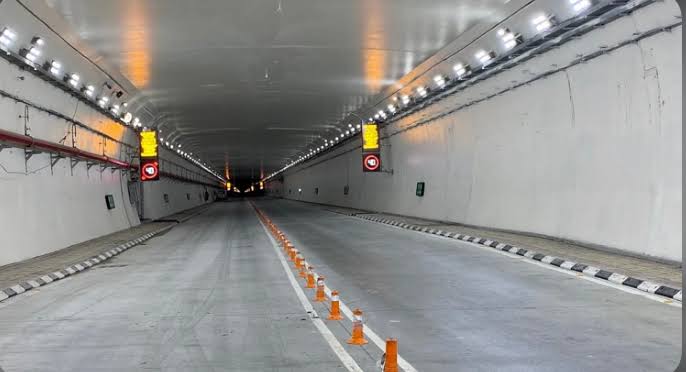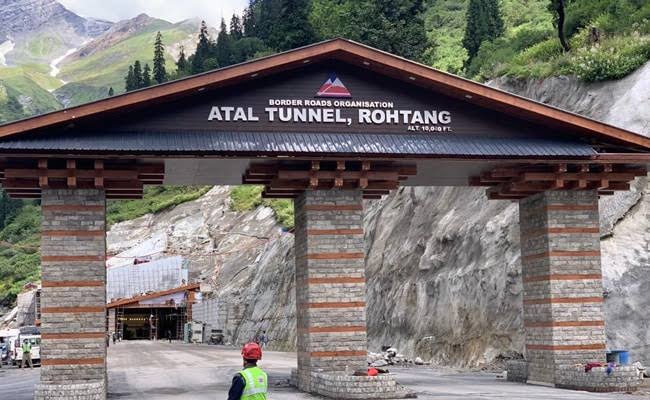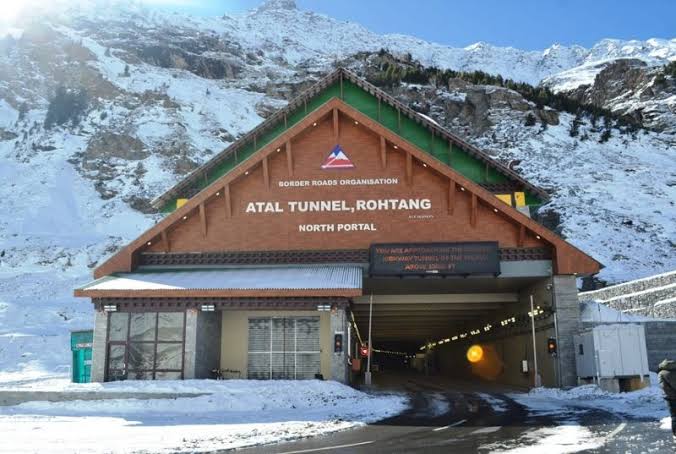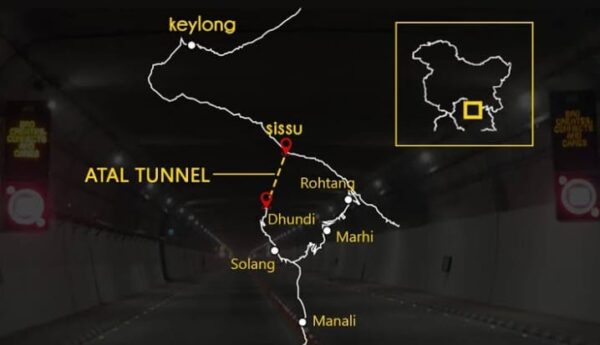Conquering the Himalayas: A Professional Perspective on the Atal Tunnel

Carved into the formidable Pir Panjal range of the Himalayas lies the Atal Tunnel (also known as Rohtang Tunnel), a testament to human ingenuity and a cornerstone of India’s infrastructural development. Named after the esteemed former Prime Minister, Atal Bihari Vajpayee, this 9.02 km marvel holds the distinction of being the world’s highest single-lane highway tunnel, exceeding 10,000 feet (3,048 meters) in altitude. Beyond its impressive engineering feat, the Atal Tunnel serves as a potent symbol of India’s resolve to bridge geographical divides and foster socio-economic progress in its remote regions.
A Long-Held Vision, Realized :

For decades, the treacherous Rohtang Pass, perched at an elevation of 3,978 meters, presented a formidable barrier to connectivity in the Himalayas. This sole gateway to Lahaul and Spiti Valley remained impassable for nearly half the year due to heavy snowfall, severing these regions from the rest of the country and hindering their development.
The concept of a tunnel to bypass the Rohtang Pass was announced by the then Prime Minister Atal Bihari Vajpayee on 3 June 2000. However, the project faced significant hurdles – the challenging terrain, harsh weather conditions at high altitude, and the sheer technical complexity of carving a path through the unforgiving mountain. On 6 May 2002, the onus fell upon the Border Roads Organisation (BRO), a paramilitary engineering force renowned for its expertise in constructing roads in inhospitable environments.
A Testament to Engineering Expertise:

The ensuing decade witnessed a relentless pursuit of this vision. In 2010, the BRO embarked on this ambitious undertaking. Constructing a tunnel at such an extreme altitude presented formidable challenges. The BRO personnel braved sub-zero temperatures, unpredictable weather patterns, and the constant threat of avalanches. Worker safety at such a high altitude was paramount, necessitating advanced life support systems and stringent safety protocols. The Border Roads Organisation (BRO) of India deserves immense credit for their ingenuity and perseverance. Utilizing sophisticated tunnel boring machines (TBMs) and meticulous blasting procedures, they carved a passage through the mountain.
The tunnel incorporates state-of-the-art safety features, including sophisticated ventilation systems, advanced fire control mechanisms, and strategically placed emergency exits. Additionally, seamless 4G connectivity ensures travelers remain connected throughout their journeys.
Finally, on October 3rd, 2020, the Atal Tunnel was inaugurated by Prime Minister Narendra Modi, marking the culmination of a decade-long endeavor. This engineering marvel not only shortened the physical distance between Manali and Keylong, but also bridged the gap between aspirations and reality for the people residing in the region.
A Benchmark Shift in Connectivity: The Atal Tunnel’s Impact

Prior to the tunnel’s construction, travelling from Manali in Himachal Pradesh to Keylong in Lahaul, a crucial leg on the route to Ladakh, was an arduous journey. The route via Rohtang Pass stretched over 116 km and could take anywhere between 5 to 6 hours, depending on weather conditions.
The Atal Tunnel has revolutionized connectivity in the region. It has slashed the travel distance to a mere 71 km, significantly reducing travel time to approximately 2 hours. This translates to not just faster commutes but also opens a window of opportunity for the Lahaul and Spiti Valley.
Socio-Economic Transformation :
The Atal Tunnel’s impact extends far beyond reducing travel time. It has ushered in a new era of socio-economic development for the Lahaul and Spiti Valley. This transformation majorly involves boost in tourism and in agricultural sector.
- Tourism Boost:
Tourism has also witnessed a significant surge. Easier access to the pristine valleys of Lahaul-Spiti and Ladakh has opened doors for travelers, leading to increased economic activity and job opportunities for local residents, fostering a vibrant tourism sector in the region. - Agricultural Advantage :
Local farmers can now transport perishable goods like peas and potatoes to markets throughout the year, minimizing spoilage and boosting their incomes. This will empower them financially and enhance agricultural livelihood in the valley.
Year-Round Accessibility :

The Atal Tunnel bypasses the treacherous Rohtang Pass, historically prone to snow blockage for extended periods due to which the region remained cut off for nearly half a year. This critical passage now offers year-round access to the previously isolated Lahaul-Spiti Valley and Ladakh, ensuring the uninterrupted flow of essential supplies, healthcare services, and educational opportunities. Travel time between Manali and these regions has been significantly reduced by 4-5 hours, fostering new opportunities for residents and businesses to actively participate in the national economy.
Enhanced National Security :
Beyond its civilian benefits, the tunnel serves an important strategic purpose. It guarantees a vital all-weather link between Himachal Pradesh and Ladakh, a crucial region bordering China, enabling faster troop deployment and more efficient movement of supplies to critical forward posts of India’s armed forces. This enhanced logistical capability strengthens national security in the strategically sensitive Himalayan region.
Challenges and the Road Ahead: Ensuring Sustainability
Despite its immense benefits, the Atal Tunnel comes with its own set of challenges. Managing traffic flow within the single-lane tunnel and ensuring environmental sustainability in this fragile ecosystem are crucial aspects that require careful planning and proactive measures.
- Traffic Management :
The tunnel can accommodate a significant volume of traffic, with a capacity of 3,000 cars and 1,500 trucks per day. A robust traffic management system with clear guidelines and signage is essential to ensure smooth movement and prevent congestion accidents. Implementing intelligent traffic control systems and promoting responsible driving behavior will be crucial in this regard. - Maintaining the tunnel in a fragile ecosystem :
The Atal Tunnel’s construction within the ecologically fragile Himalayas necessitated meticulous planning to minimize environmental disruption. Ongoing efforts focus on ensuring long-term geotechnical stability of the surrounding slopes and mitigating potential ecological disruptions. - Dealing with unpredictable weather :
The region experiences extreme weather conditions, including heavy snowfall and avalanches. Maintaining year-round operability requires robust snow clearing mechanisms, coupled with advanced weather monitoring systems for proactive incident management.
The Atal Tunnel stands as a powerful symbol of India’s engineering prowess and unwavering commitment to development. It has transformed the lives of people in the Himalayas by fostering economic growth, strengthening national security, and creating a brighter future for the region. As you plan your travels in Himachal Pradesh, consider including this marvel of engineering on your itinerary for a truly enriching experience.
What is the Atal Tunnel?
The Atal Tunnel is the world’s highest single-lane tunnel for motor vehicles, located in the Pir Panjal Himalayas on National Highway 3, India.
Why is it named Atal Tunnel?
It’s named after former Indian Prime Minister Atal Bihari Vajpayee, who envisioned the project in 2000.
How long is the Atal Tunnel?
The tunnel stretches for an impressive 9.02 kilometers (5.6 miles).
What was the purpose of building the Atal Tunnel?
The tunnel bypasses the treacherous Rohtang Pass, which is closed for nearly six months due to heavy snowfall. It provides year-round connectivity to the Lahaul and Spiti Valleys in Himachal Pradesh.
How much time does the Atal Tunnel save?
The tunnel reduces travel time between Manali and Leh by 4-5 hours and shortens the distance by 46 kilometers.
When was the Atal Tunnel inaugurated?
The tunnel was officially opened in October 2020 by Prime Minister Narendra Modi.
What is the construction cost of the Atal Tunnel?
The tunnel’s construction was estimated to cost around ₹3,500 crore (US$4.6 billion).
What type of vehicles are allowed in the Atal Tunnel?
Most standard passenger vehicles like cars, SUVs, and buses can pass through. Restrictions might apply to heavy trucks based on weight and size.
What is the speed limit inside the Atal Tunnel?
The speed limit within the tunnel is generally between 40-60 kilometers per hour.
Does the Atal Tunnel have safety features?
Absolutely. The tunnel boasts modern safety measures like CCTV cameras, emergency exit tunnels every 500 meters, air quality monitoring, and automatic incident detection systems.
Is there a walking lane in the Atal Tunnel?
No, the Atal Tunnel is a single-tube tunnel with two lanes for motorized vehicles. However, some sources mention a lane closure for controlled pedestrian movement during specific times. It’s advisable to check for official updates.
Can you stop your car inside the Atal Tunnel?
Stopping inside the tunnel is strictly prohibited for safety reasons.
What is the altitude of the Atal Tunnel?
The Atal Tunnel is located at an altitude of approximately 3,000 meters (10,000 feet).
Does the Atal Tunnel have phone connectivity?
Yes, the tunnel has telephone facilities at regular intervals for emergencies.
How is air quality maintained inside the Atal Tunnel?
The tunnel is equipped with an air quality monitoring system to ensure safe and comfortable passage for vehicles.
What happens in case of a fire inside the Atal Tunnel?
Fire hydrants are positioned at every 60 meters to tackle emergencies.
Is there a broadcast system inside the Atal Tunnel?
The tunnel has a broadcasting system for important announcements and safety advisories.
What is the expected traffic flow through the Atal Tunnel?
The tunnel is designed to handle a traffic density of 3,000 cars and 1,500 trucks per day.
How long did it take to construct the Atal Tunnel?
Construction of the Atal Tunnel took around 10 years to complete.
What is the impact of the Atal Tunnel on the region?
The tunnel has significantly improved connectivity, boosted tourism in Himachal Pradesh, and provided a vital year-round link for the Lahaul and Spiti Valleys.

Dikshit Sharma is an inquisitive writer with a passion for uncovering the stories behind everyday life. His work features themes like food, culture, travel and much more. Whether it’s delving into local culture or exploring hidden trends, he loves to weave captivating narratives that bring everyday experiences to life with vivid storytelling.





